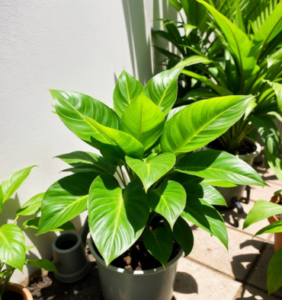Introduction to Taxonomy and Its Importance in Botany
If you’ve ever marveled at the diversity of plants in your garden or a botanical garden, you might have wondered how scientists keep track of so many different species. The answer lies in taxonomy—the importance of plant taxonomy in gardening and botany, which classifies living organisms into hierarchical categories. For plant enthusiasts, botanists, and gardeners, understanding plant taxonomy is crucial for identifying plants accurately, sharing information about them, and ensuring proper care.
Taxonomy isn’t just a dry academic exercise; it has practical applications that directly impact how we interact with the plant world. From selecting the right Philodendron species for your garden to understanding how different plants are related, botanical classification offers valuable insights to enhance your gardening experience. In this blog post, we’ll explore the fascinating world of scientific classification using the popular houseplant genus, Philodendron, as our guide.
By the end of this post, you’ll have a deeper appreciation for the intricacies of plant taxonomy and how it can benefit you as a plant lover. We’ll cover the seven levels of scientific classification, provide detailed explanations of each level using Philodendron as an example, and discuss the significance and practical applications of taxonomy in gardening and botany, including insights on plant families, genus and species identification, and even how to differentiate between Monstera vs. Philodendron.
Overview of the 7 Levels of Scientific Classification
Scientific classification, also known as taxonomy, is the systematic categorization of living organisms into hierarchical groups based on their characteristics and evolutionary relationships. The system was developed by Carl Linnaeus in the 18th century and has since evolved to incorporate modern genetic insights.
The seven primary levels of classification are:
- Kingdom
- Phylum
- Class
- Order
- Family
- Genus
- Species
Each level represents a rank in the hierarchy, with Kingdom being the broadest category and Species being the most specific. By sorting organisms into these levels, scientists can communicate more effectively about biodiversity and evolutionary history.
Understanding these levels helps in identifying plants correctly, which is essential for research, conservation, and horticulture. Now, let’s take a closer look at each taxonomic level using our example genus, Philodendron.
Detailed Explanation of Each Taxonomic Level Using Philodendron as an Example
Kingdom
The highest and most inclusive category is the Kingdom. All plants fall under the Plantae kingdom, encompassing many organisms, from tiny mosses to towering trees. Members of this kingdom are primarily autotrophic, meaning they produce their food through photosynthesis.
Philodendrons, like all other plants, belong to the Plantae kingdom. This plant taxonomy classification sets the stage for further narrowing down their identity within the plant kingdom
Phylum
The Plantae kingdom divides plants into different Phyla based on their distinct characteristics. The Philodendron classification belongs to the Phylum Magnoliophyte, also known as angiosperms or flowering plants. This phylum includes all plants that produce flowers and seeds enclosed in fruit.
Angiosperms are the most diverse group of plants on Earth, accounting for approximately 80% of all known plant species. The classification of Philodendrons under Magnoliophyte highlights their shared traits with other flowering plants.
Class
The next level in the hierarchy is Class. Philodendrons fall under the Class Liliopsid, commonly referred to as monocots. Monocots vs. dicots are distinguished by having a single cotyledon (seed leaf) in their seeds, parallel leaf venation, and fibrous root systems.
Other well-known monocots include grasses, lilies, and orchids. Recognizing Philodendrons as monocots helps botanists understand their growth patterns and developmental processes.
Order
Within each class, plants are further grouped into orders based on more specific shared characteristics. Philodendrons belong to the Alisma tales order, a diverse group that includes many aquatic and semi-aquatic plants.
The classification of Philodendrons within the Alisma tales order provides insights into their evolutionary history of plants and ecological adaptations. This order is known for its unique inflorescence structure and specialized habitats
Family
The Family level narrows down the classification even further. Philodendrons are part of the Family Araceae, commonly known as the arum family or aroid family. This family is famous for its distinctive inflorescence, known as a spadix, which is often surrounded by a spathe.
Aroids are popular in both horticulture and interior design due to their striking foliage and unique flowers. Other members of the Araceae family include peace lilies, anthuriums, and taro.
Genus
The Genus is a critical level of classification that groups species based on closely related characteristics. Philodendrons belong to the Genus Philodendron, which comprises over 400 species known for their attractive leaves and adaptability to indoor environments.
The name “Philodendron” comes from the Greek words “Philo” (love) and “dendron” (tree), reflecting the plant’s affinity for climbing and wrapping around trees in its natural habitat.
Species
The species level is the most specific and defines individual organisms that can interbreed and produce fertile offspring. Within the Philodendron genus, there are numerous species, such as Philodendron hederaceum (heartleaf philodendron) and Philodendron bipinnatifidum (split-leaf philodendron).
Each species has unique traits and care requirements, making this level vital for gardeners and botanists who want to provide optimal conditions for their plants.
The Significance of Understanding Scientific Classification for Plant Enthusiasts
For plant enthusiasts, understanding scientific classification is more than just an academic exercise. It offers practical benefits that can enhance your gardening experience and deepen your appreciation for the natural world.
By knowing the taxonomy of your plants, you can make informed decisions about their care, placement, and propagation. For example, recognizing a plant as a member of the Araceae family can help you understand its watering and light requirements.
Taxonomy also fosters a sense of connection to the broader plant community. When you share your knowledge with other enthusiasts, you contribute to a collective understanding of plant diversity and conservation.
Practical Applications of Taxonomy in Gardening and Botany
Identifying Plants Accurately
Accurate plant identification is crucial for effective gardening and botanical research. Taxonomy provides a standardized system for naming and categorizing plants, ensuring everyone speaks the same “language.”
Knowing a plant’s scientific name can help you access reliable information about its care and characteristics. This knowledge is beneficial when dealing with uncommon or exotic species.
Enhancing Plant Breeding and Conservation
Taxonomy plays a vital role in plant breeding and conservation efforts. Botanists can develop new hybrids and cultivars with desirable traits by understanding the evolutionary relationships between different species.
In conservation, taxonomy helps identify endangered species and prioritize them for protection. Accurate classification also aids in recognizing invasive species that threaten native ecosystems.
Facilitating Communication Among Gardeners and Botanists
A shared understanding of plant classification fosters effective communication among gardeners, botanists, and horticulturists. Whether you’re discussing plant care tips or collaborating on research projects, taxonomy ensures that everyone is on the same page.
This common language also extends to the commercial nursery industry, where accurate labeling of plants is essential for customer satisfaction and regulatory compliance.
Summary
Exploring the world of plant taxonomy can be a rewarding experience for any plant enthusiast, botanist, or gardener. By understanding the principles of scientific classification, you gain valuable insights into the diversity and complexity of the plant kingdom.
From the broadest category of Kingdom to the most specific level of Species, each taxonomic rank offers a glimpse into the evolutionary history and unique characteristics of plants. Using Philodendrons as an example, we’ve seen how taxonomy can enhance our understanding and appreciation of these beloved houseplants.
We encourage you to continue exploring the fascinating world of plant taxonomy. Whether you’re identifying a new addition to your garden or researching plant conservation strategies, the knowledge you gain will enrich your connection to the natural world.
To further enhance your understanding of plant taxonomy and get personalized advice, consider booking a consultation with one of our expert botanists. Together, we can unlock the full potential of your garden and foster a deeper appreciation for the beauty and diversity of plants.
Frequenty Asked Questions
Plant taxonomy helps gardeners identify plants accurately, ensuring they provide the correct care and understand the plants’ growth patterns and needs.
The seven levels are Kingdom, Phylum, Class, Order, Family, Genus, and Species.
Though both belong to the Araceae family, Monstera and Philodendron are different genera, with unique growth habits and leaf structures.
Recognizing a plant’s family helps you understand its general characteristics, like water and light needs, since related plants often have similar care requirements.













